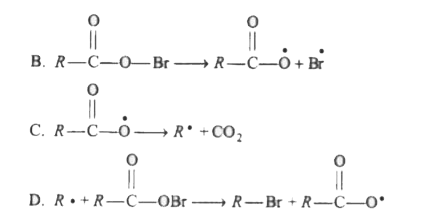Write the free radical mechanism for the polymerisation of ethene.
Step-by-Step Solution for Free Radical Mechanism of Ethene Polymerization
Step 1: Chain Initiation
1. Initiator Decomposition: The process begins with the decomposition of a free radical initiator, such as benzoyl peroxide. When heated, benzoyl peroxide breaks down to produce two benzoyloxy radicals.
Benzoyl peroxideheat−−→2C6H5COO∙
2. Formation of Free Radicals: The benzoyloxy radicals further decompose to generate free radicals (R) and carbon dioxide.
C6H5COO∙→C6H∙5+CO2
3. Reaction with Ethene: The generated free radical (R) reacts with an ethene molecule (C₂H₄) to form an ethyl radical.
R+C2H4→RCH2CH∙2
Step 2: Chain Propagation
1. Radical Addition: The ethyl radical (RCH₂CH₂˙) reacts with another ethene molecule, adding to the chain and forming a longer radical.
RCH2CH∙2+C2H4→RCH2CH2CH2CH∙2
2. Continued Propagation: This process continues as the growing radical reacts with additional ethene molecules, leading to the formation of a longer polymer chain:
RCH2CH∙2+nC2H4→RCH2CH2CH2…CH∙2
Step 3: Chain Termination
1. Radical Combination: The polymer chain can terminate by combining with another radical (either from the initiator or another growing polymer chain).
RCH2CH2…CH∙2+R'∙→Polyethene
2. Formation of Polyethene: The final product is a long-chain polymer known as polyethene (or polyethylene).
Polyethene=(C2H4)n
Summary of the Free Radical Mechanism
- Initiation: Free radicals are generated from an initiator.
- Propagation: The radicals react with ethene to form a growing polymer chain.
- Termination: The chain is terminated by radical combination, resulting in the formation of polyethene.
1. Initiator Decomposition: The process begins with the decomposition of a free radical initiator, such as benzoyl peroxide. When heated, benzoyl peroxide breaks down to produce two benzoyloxy radicals.
Benzoyl peroxideheat−−→2C6H5COO∙
C6H5COO∙→C6H∙5+CO2
R+C2H4→RCH2CH∙2
1. Radical Addition: The ethyl radical (RCH₂CH₂˙) reacts with another ethene molecule, adding to the chain and forming a longer radical.
RCH2CH∙2+C2H4→RCH2CH2CH2CH∙2
RCH2CH∙2+nC2H4→RCH2CH2CH2…CH∙2
1. Radical Combination: The polymer chain can terminate by combining with another radical (either from the initiator or another growing polymer chain).
RCH2CH2…CH∙2+R'∙→Polyethene
Polyethene=(C2H4)n
- Initiation: Free radicals are generated from an initiator.
- Propagation: The radicals react with ethene to form a growing polymer chain.
- Termination: The chain is terminated by radical combination, resulting in the formation of polyethene.
Topper's Solved these Questions
- XII BOARDSBOOK - XII BOARD PREVIOUS YEAR PAPER ENGLISHCHAPTER - XII BOARDSEXERCISE - SET-II
32 Videos
- XII BOARDSBOOK - XII BOARD PREVIOUS YEAR PAPER ENGLISHCHAPTER - XII BOARDSEXERCISE - SET-III
31 Videos
- SAMPLE PAPER 2019BOOK - XII BOARD PREVIOUS YEAR PAPER ENGLISHCHAPTER - SAMPLE PAPER 2019EXERCISE - SECTION: D
1 Videos
Similar Questions
Knowledge Check
Free radicals can undergo
Arearrangement to a more stable free radicalBdecomposition to give another free radicalCcombination with other free radicalDall are correctThe Hunsdiecker reaction is believed to proceed by a free radical mechanism and involves the formation of an acyl hypohalite.


The major product is :APh−CH=CH−−∣CH3BrBPh−Br∣CH−CH=CH−CH3CPh−CH=Br∣C−CH2−CH3DP−CH=CH−C∣CH3H−CH2BrThe Hunsdiecker reaction is believed to proceed by a free radical mechanism and involves the formation of an acyl hypohalite.


 A
A B
B C
C D
D
When two free radicals collide
View SolutionWhat is true regarding free radical polymerization of ethylene?
View SolutionThe free radical which is most stable is
View SolutionWrite down the heteroheneous catalyst involved in the polymerisation of ethylene.
View SolutionThe Hunsdiecker reaction is believed to proceed by a free radical mechanism and involves the formation of an acyl hypohalite.


The rate determining step is :
View Solution
